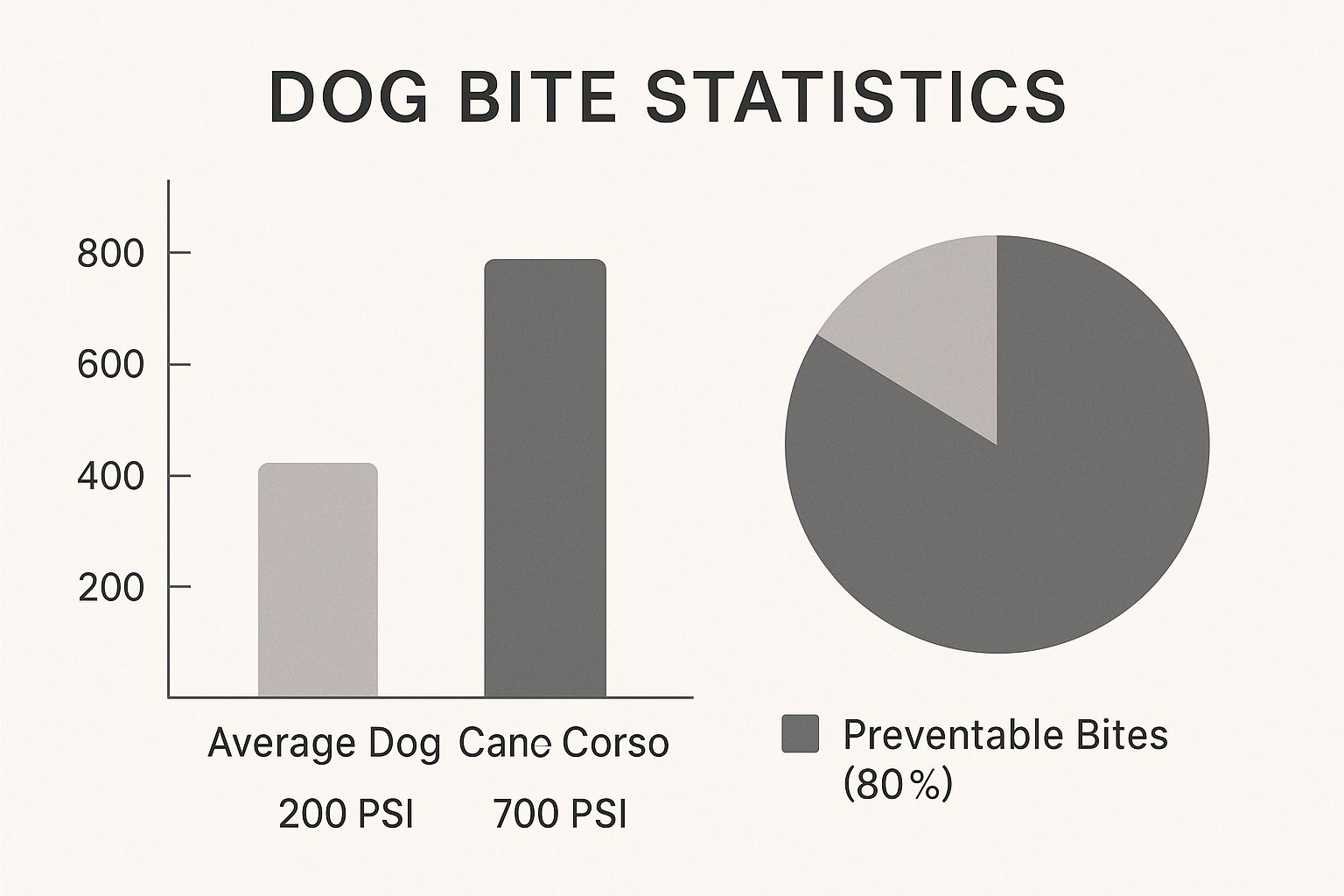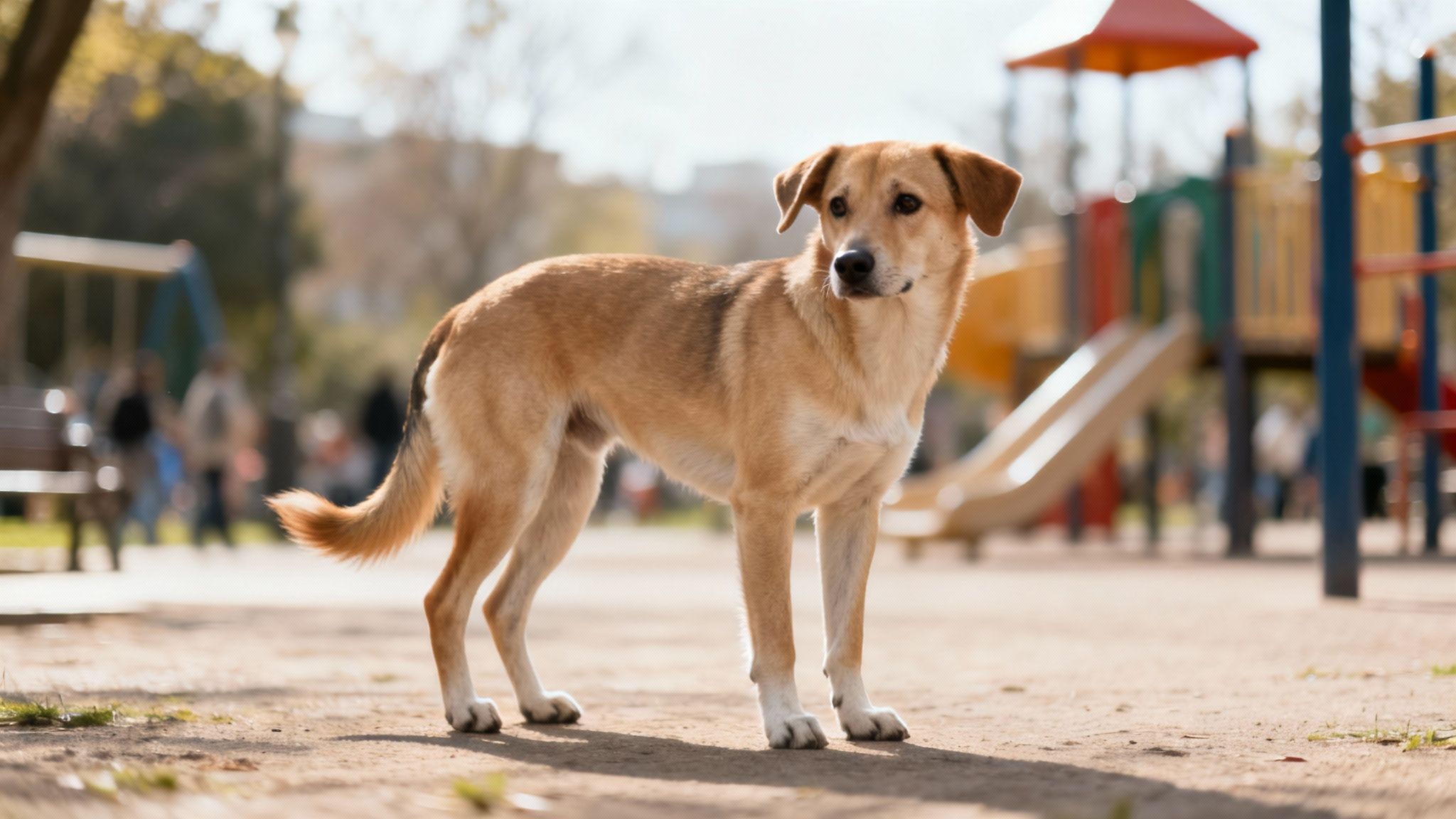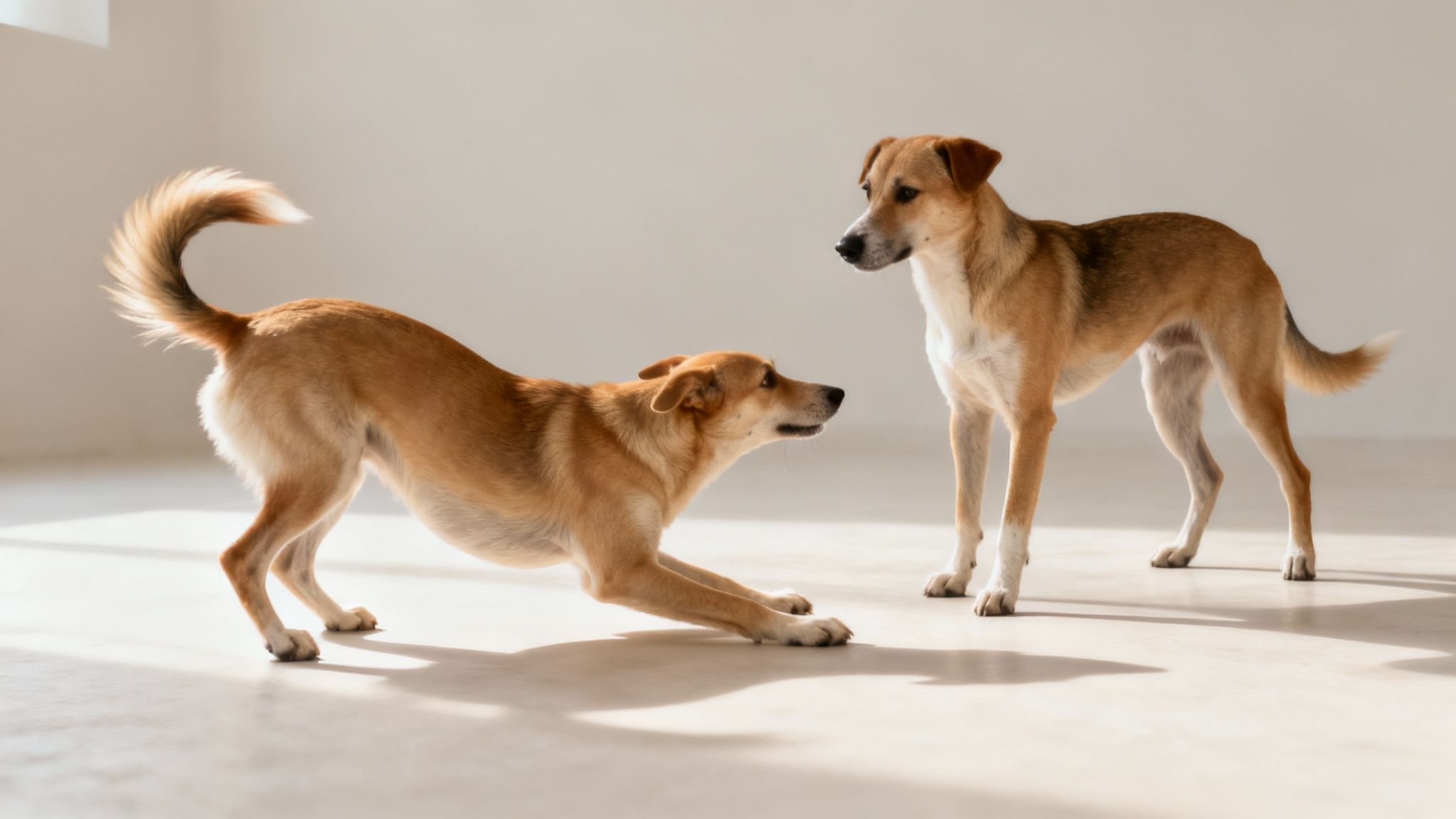Learning to read your dog’s body language is like decoding a secret conversation. It’s all about understanding the silent messages they send through their posture, tail, ears, and eyes. This is the real key to building trust, staying safe, and deepening your bond, letting you figure out their feelings and intentions long before you ever hear a bark or a growl.
Why Your Dog’s Silent Signals Are So Important

Would you put your hand into the back of the mouth of a Cane Corso? Perhaps not the best of moves when the Cane Corso is the second most deadly dog in the world based on its bite pressure of around 700 pounds per square inch. I’m proud to say I have! You see one of my clients dogs is a Cane Corso called Panther and one day I arrived to find her pawing her mouth and in distress because a large knuckle bone had lodged at the back of her upper mouth lodged between her two rows of teeth.
Bearing in mind that had she swallowed it she would probably have choked to death I didn’t hesitate and gently put my hand in her mouth and pulled the offending bone out!
Trust Forged Through Understanding
On the face of it, was that a risky move? Absolutely. But I knew she needed my help, and crucially, she knew that too. The way she was pawing at her mouth was a clear signal—a desperate plea for assistance, not a threat of any kind.
And that’s precisely why observing and understanding a dog’s body language is so vital. It can transform a potentially dangerous situation into a moment of profound trust. It’s not just about avoiding bites; it’s about building a partnership where your dog sees you as a safe, reliable leader who gets what they need.
When we learn to listen with our eyes, we open up a whole new level of communication. We move beyond just caring for our dogs and start truly understanding them, which is the foundation of any great relationship.
A deeper understanding of your dog’s non-verbal cues is also key to unlocking the surprising ways owning a pet can improve your health and well-being. When you can confidently read their signals, the stress of uncertainty just melts away for both of you.
The High Stakes of Misinterpretation
The difference between a safe interaction and a serious incident often comes down to reading those subtle clues that come before any big reaction. The infographic below highlights the immense power certain breeds possess and, more importantly, how many dangerous situations could be avoided altogether.

The data makes it crystal clear: while some dogs have a truly formidable bite, a massive majority of incidents are preventable if we just learn to recognise the warning signs.
Learning this silent language empowers you to act proactively, not reactively. You can de-escalate a tense situation at the park or comfort your anxious pup during a thunderstorm, simply by noticing their tucked tail or wide eyes.
Decoding Canine Signals from Head to Tail

To really get what a dog is telling you, we need to learn their alphabet before trying to read whole sentences. Dogs chat with their entire bodies, and every tiny shift—from their ears and eyes to their mouth and tail—is a word in a much bigger message.
Let’s break these signals down piece by piece, starting right at the top.
The Eyes and Ears Tell a Story
The first place we usually look is a dog’s face, and for good reason. Their eyes and ears are incredibly expressive and give you an instant feel for their emotional state.
A dog’s eyes can be either soft or hard. Soft eyes are relaxed, with normal-sized pupils, and they might even look a bit squinty. This is the look of a content, happy dog. A hard eye, on the other hand, is a clear warning. The gaze goes cold and fixed, often with wide, dilated pupils, signalling tension, fear, or a potential threat. You’ll know it when you see it.
Also, keep an eye out for “whale eye,” where a dog turns its head but keeps its eyes locked on something, showing the whites in a crescent shape. This is a classic sign of anxiety, telling you they feel backed into a corner or deeply uncomfortable.
Their ears work like emotional satellite dishes. Here’s what to look for:
- Forward and alert: The dog is interested, curious, or focused on something.
- Relaxed and neutral: This is their natural, comfortable state. The ears will sit in their normal position for their breed.
- Pinned back and flat: This is a strong signal of fear, anxiety, or submission. The dog is trying to make itself smaller and non-threatening.
Mouth Signals and Misunderstood Messages
The mouth is another area that’s easily misinterpreted. We often think we know what a yawn or a lick means, but in a dog’s world, these signals carry very different weights.
A quick lip lick when there’s no food around isn’t your dog dreaming of dinner. It’s usually an appeasement or stress signal—their way of saying, “I’m a bit uncomfortable with this.” In the same way, a yawn isn’t always about being tired; it’s a common displacement behaviour they use to relieve stress.
This is where many of us get it wrong. A startling 2023 study by The Kennel Club found that up to 90% of UK dog owners struggle to identify key stress signals. Despite 72% believing they read their dog well, common signs like yawning were missed by 88% of owners, and lip licking was only recognised by 18%. To learn more about these commonly missed cues, you can explore the full findings of The Kennel Club’s research.
Baring teeth might seem like an obvious threat, but even this can be deceptive. A submissive grin, where a dog shows its front teeth, is often paired with a wiggly body and is a sign of appeasement, not aggression. Context is everything.
You can also explore the complexities of this specific signal in our detailed guide on why dogs lick their lips. Getting to grips with this common but often misunderstood behaviour is a big step forward.
Common Canine Stress Signals at a Glance
It’s easy to miss the more subtle signs of stress. This quick guide can help you spot the signals that often get misinterpreted.
| Signal | What It Often Means | Common Misinterpretation |
|---|---|---|
| Yawning | Anxiety, stress, or trying to calm a situation down. | The dog is just tired. |
| Lip Licking | Feeling uncomfortable, nervous, or appeasing a perceived threat. | They are hungry or thirsty. |
| Whale Eye | Anxiety or feeling threatened and cornered. | Just looking sideways. |
| Panting (no heat/exercise) | Stress, fear, or pain. | The dog is simply hot. |
| Shaking Off (when not wet) | “Shaking off” a stressful encounter or moment. | Just a random body shake. |
Remember, these signals are your dog’s way of whispering that they’re not okay. Learning to hear them is one of the kindest things you can do.
The Truth About The Tail Wag
Perhaps the biggest myth in dog body language is that a wagging tail always means a happy dog. The truth is, a wag simply shows emotional arousal, which could be anything from joy to fear. The type of wag is what tells you the real story.
Think of the tail as an emotional barometer. The height and speed of the wag are your main clues.
Common Tail Positions and Their Meanings
| Tail Position & Movement | What It Often Means | Common Misinterpretation |
|---|---|---|
| Broad, sweeping wag | A relaxed, happy, and friendly dog. Often the whole body wags with it. | All wags are friendly. |
| High, stiff, fast wag | High arousal, assertiveness, or a potential warning. This dog is on high alert. | Simple excitement or playfulness. |
| Low or tucked wag | Fear, anxiety, or submission. The dog feels insecure and is trying to be non-threatening. | The dog is being stubborn or guilty. |
| Neutral position | The dog is calm and relaxed. This baseline varies hugely between breeds. | A still tail means nothing. |
By looking at the tail along with the eyes, ears, and mouth, you start to build a much clearer picture. A high, fast wag paired with a hard stare is a world away from a soft, sweeping wag with relaxed eyes. This holistic view is the secret to truly understanding what your dog is trying to tell you.
Reading the Full Picture: Why Context Is Everything

Right, we’ve broken down all the individual signals from head to tail. Now it’s time to put it all together. Think of it like this: a single signal, like a wagging tail or a lip lick, is just one word. To really get what your dog is trying to tell you, you need to read the entire sentence—their whole body—and understand the situation it’s all happening in.
This is where context becomes your most powerful tool. A dog’s behaviour is never just a random action; it’s a direct response to their environment, their emotional state, and the people or other animals around them. Ignoring the context is like trying to understand a conversation by only hearing every tenth word. You’ll get bits and pieces, but you’ll completely miss the real meaning.
Take panting, for example. A dog panting in the back of a cool car on a hot day is probably just cooling down. Simple. But a dog panting heavily at the vet’s surgery, with a tucked tail and wide, darting eyes? That’s a completely different story. Same action, but the context tells us this dog is clearly stressed and scared.
The Importance of the Whole-Body Approach
Zeroing in on just one part of a dog, like their tail or face, can lead to some seriously dangerous misunderstandings. This isn’t just an opinion from a dog walker; it’s backed by how we humans actually perceive their signals.
A fascinating psychological study from Lincoln University had people watch videos of dogs showing different emotions. The results were quite telling. Participants were best at identifying happiness when they could see the dog’s entire body. But fear? That was often completely misread when viewers could only see the dog’s face. The research confirmed what experienced dog people have known for years: a full-body observation is crucial for accurately reading emotions like fear, pain, or sadness. You can discover more insights from this fascinating study on canine emotions.
This teaches us a vital lesson: always zoom out. Look at the complete picture. Is the dog’s body loose and wiggly, or is it stiff and rigid? Are their eyes soft or hard? The combination of these signals, not just one in isolation, tells you the truth of the matter.
Connecting the Dots in Real-World Scenarios
Let’s put this into practice. By looking at the dog’s body language alongside their environment, we can build a much clearer picture of what they’re feeling.
Imagine two different dogs, both with a tucked tail.
- Dog A: He’s at a noisy, crowded park with children running everywhere. His body is tense, his ears are pinned back, and he’s repeatedly licking his lips. Here, the tucked tail is part of a bigger picture showing he’s completely overwhelmed and fearful. He’s asking to leave, loud and clear.
- Dog B: She’s at home, having just chewed up a new pair of shoes. Her owner is standing over her, using a stern voice. Her tail is tucked, she’s avoiding eye contact, and her body is low to the ground. This isn’t guilt; it’s appeasement. She’s responding to your intimidating posture and tone by trying to signal that she isn’t a threat.
By learning to see the whole dog in their whole world, you move from simply reacting to their behaviour to truly understanding their feelings. This empathetic approach is the key to building trust and preventing misunderstandings before they start.
This is the skill that helps you become your dog’s best advocate. You’ll know when to step in and create space for them at the park, or when to soften your own body language at home to help them feel safe again. It’s about listening with your eyes, not just your ears.
Decoding Common Real-World Scenarios

Alright, we’ve covered the individual “words” of your dog’s language. Now it’s time to see how they form full sentences out in the real world. Let’s put your new skills to the test in a few practical, everyday situations.
After all, this is where the theory really matters—when you can apply it in the moment to keep everyone safe and happy. By breaking down these common interactions, you’ll soon start spotting the subtle conversations happening all around you.
Scenario 1: The Dog Park Greeting
This is one of the most complex, high-stakes interactions you’ll come across. A good greeting can kick off a brilliant play session, but a bad one can quickly escalate into a fight. The key is knowing how to spot a polite, friendly “hello” versus a tense, uncertain standoff.
A positive greeting often begins with a curved approach. Dogs who mean well rarely walk straight at each other; instead, they’ll approach from the side in a gentle arc. You should be looking for loose, wiggly bodies and maybe even a play bow—that classic “bum in the air” invitation to chase.
On the other hand, a tense greeting looks very different. Watch out for:
- Stiff, rigid bodies: The dogs might look like statues, moving slowly and deliberately.
- Direct, hard stares: Unbroken eye contact isn’t a friendly gesture; it’s a challenge.
- High, stiff tail wags: Remember, a fast, high wag isn’t always happy. It signals high arousal.
- Circling: The dogs may circle each other stiffly, often nose-to-tail.
If you spot these warning signs, it’s time to calmly step in. Use a happy, upbeat tone to call your dog away and create some space. Whatever you do, don’t yank on the lead, as this can ramp up the tension.
Scenario 2: The Stranger at the Door
The doorbell rings, and chaos erupts. Is your dog just excited to meet a new friend, or are they feeling anxious and territorial? Reading their signals here is crucial for managing the situation safely.
A dog showing friendly curiosity will have a loose, relaxed body. Their ears will be forward, and their tail will likely have a broad, sweeping wag. They might bark, but it’s often a higher-pitched, excited sound rather than a deep, threatening one.
A dog feeling anxious or territorial, however, will display a very different set of signals. You might see a stiff body with weight shifted forward, a hard stare fixed on the door, and maybe even raised hackles along their back. Their bark will be lower and more forceful. If your dog shows these signs, it’s a clear indication they’re feeling overwhelmed. Understanding these signals is the first step, and you can learn more about the common dog anxiety symptoms in our detailed guide.
Your role in this moment is to be your dog’s advocate. Acknowledge their feelings by calmly managing the situation—perhaps by putting them in another room with a tasty chew before you open the door. This shows them you have the situation under control, which helps them relax.
Scenario 3: The Child and Dog Interaction
This is a scenario where understanding dog body language is absolutely non-negotiable for safety. Children communicate very differently from adults, and their well-intentioned actions, like hugging or getting right in a dog’s face, can be deeply threatening to a canine.
It’s our job as adults to supervise and spot the subtle signs of stress a dog will show long before they feel the need to growl or snap. These are your dog’s whispers for help.
Look for these key stress signals in the dog:
- Whale Eye: The dog turns its head away but keeps its eyes fixed on the child, showing the whites of its eyes.
- Lip Licking and Yawning: These are classic calming signals that show the dog is uncomfortable.
- Turning Away: The dog is actively trying to create space and get out of the situation.
- Freezing: A sudden stillness or rigidity is a major red flag that the dog is incredibly stressed.
If you see any of these signals, you must intervene immediately and gently. Create space by calling the child away or calmly leading the dog to a quiet spot where they can decompress. Teaching children to respect a dog’s need for space is one of the most important lessons we can share, ensuring our homes are safe and happy for everyone.
The Risks of Misreading Canine Signals
When we get it wrong—when we misinterpret what our dogs are desperately trying to tell us—the consequences can be serious. This isn’t just about a missed cue. It’s a breakdown in communication that can put our dogs, our families, and others at risk.
But understanding the gravity of these mistakes isn’t about scaremongering. It’s about empowering you with the knowledge to stop problems before they even start.
Ignoring those early warnings is a massive gamble. A low growl when someone gets near their food bowl, freezing over a toy, or showing the whites of their eyes (“whale eye”) when a child gets too close are not the signs of a “bad dog”. They are clear, deliberate signals that a dog feels threatened or simply isn’t coping.
When we fail to listen to these whispers, we often force them to shout.
The Escalation Ladder
Think of a dog’s warnings as steps on a ladder. A dog will nearly always start at the bottom with subtle signs, things like yawning out of context or a quick lip lick.
If those go unnoticed, they might turn their head away, then freeze, then growl, and only as a last resort, bite.
Punishing a growl is one of the most dangerous things an owner can do. It’s like taking the batteries out of a smoke alarm. You haven’t stopped the fire; you’ve just silenced the warning that it’s coming. A dog that’s been taught not to growl might just go straight from freezing to biting, leaving everyone shocked by the seemingly “sudden” attack.
By learning to spot and respect the early, quieter signals, you give your dog the confidence that they don’t need to escalate their behaviour. You’re showing them that you hear them and that you’ll keep them safe, which is the foundation of a trusting relationship.
This ability to read our dogs correctly is becoming more critical than ever. Recent research from Edge Hill University has linked a 34% rise in recorded dog attacks in England and Wales over the last five years directly to a widespread misunderstanding of dog body language. The study found that many people incorrectly assume dogs won’t bite children and commonly misread the clear warnings dogs give before things escalate. You can learn more about these important findings on dog behaviour.
Fostering Safer Communities
Ultimately, a wider community understanding of dog body language creates a safer environment for everyone. When we can all recognise a dog who needs a bit of space, we reduce the chances of accidental bites in parks, on walks, and in our own homes.
If you are struggling with your dog’s behaviour, it’s essential to realise these signals are a cry for help, not a challenge. For more guidance on this complex topic, check out our in-depth article on how to handle dog aggression. By becoming fluent in their language, we become better owners, more responsible members of the community, and the trusted guardians our dogs deserve.
Your Questions on Dog Body Language Answered
To help you feel more confident about understanding what your dog is trying to tell you, I’ve put together answers to some of the most common questions I hear. These are practical, clear answers to tackle frequent points of confusion, giving you advice you can use straight away.
Does a Wagging Tail Always Mean a Dog Is Friendly?
Absolutely not. This is probably one of the most dangerous myths in the world of dog communication. It’s true that a relaxed, sweeping wag that involves the whole body often means a happy, friendly dog. But a tail is a far more complex signal than that.
Think of a wagging tail as a sign of emotional arousal – it just means the dog is stimulated and ready to react. The real message is in how it’s wagging. A tail held high with stiff, rapid, almost twitchy wags can be a serious warning sign. To get the full story, you have to look at the dog’s entire body. A stiff posture, a hard stare, and that high, fast wag is a clear signal to create distance, not to lean in for a pat.
What Is the Most Important Sign of Anxiety to Look For?
While there are many signals, one of the most overlooked and critical indicators of stress is the “whale eye.” This is when a dog turns its head away from something but keeps its eyes locked onto it, showing the whites of its eyes in a crescent shape. When you see this, your dog is feeling significant stress and is desperately looking for a way out of the situation.
Other subtle signs often appear in a cluster alongside whale eye, so keep a lookout for:
- Lip licking: Quick little flicks of the tongue when there’s no food around.
- Yawning: A yawn that’s out of context (i.e., not when they’re tired) is a classic calming signal.
- Tucked tail: The dog is trying to make itself smaller and appear non-threatening.
Spotting these early allows you to become your dog’s advocate. You can get them out of a stressful situation before their fear escalates into a bigger reaction.
How Can I Teach Children to Read Dog Body Language?
Teaching children how to interact safely with dogs is absolutely vital for preventing bites and building a respectful bond. The trick is to keep the rules simple, clear, and consistent.
Start with the basics. A brilliant rule is to teach them to “Be a Tree” if a strange or overly excited dog approaches. That means standing still and quiet with their arms folded. This simple action makes them far less interesting and less threatening to the dog.
Another essential lesson is “No Hugs, No Kisses.” While we see this as affectionate, close facial contact and wrapping arms around a dog’s neck can feel incredibly threatening and confining to them.
Finally, give them a simple three-step process for meeting new dogs:
- Always ask the owner’s permission first. This teaches respect for both the dog and its person.
- Let the dog approach and sniff them first. Teach them to offer the back of their hand for the dog to investigate on its own terms.
- Pat the dog gently on its side or chest, never reaching over the top of its head.
Using photos or even cartoons to show the difference between a happy, relaxed dog and one that looks stiff, has its ears back, or is trying to move away can also be a fantastic visual aid for younger children.
What Does It Mean When My Dog Growls Near Its Food?
This behaviour is known as resource guarding, and a growl is your dog’s way of communicating very clearly, “I feel threatened by you being so close, and I’m worried you’re going to take my food. Please back away.”
The most important thing to remember is to never, ever punish the growl. A growl is a crucial warning signal. If you punish your dog for growling, you risk teaching them not to give a warning before escalating straight to a bite. It’s like taking the batteries out of a smoke alarm.
Instead, the goal is to change how your dog feels about you being near their food. You want them to think your presence is a good thing. From a safe distance, toss high-value treats (like little bits of chicken or cheese) toward their bowl as you walk by. This helps your dog build a positive association—your approach means something wonderful appears. For any serious cases of resource guarding, it’s always best to get in touch with a qualified, force-free professional dog trainer for guidance.
At K9 Time, we believe that understanding your dog is the foundation of a safe, happy, and trusting relationship. If you’re looking for a dog walker in Sheffield who prioritises one-to-one attention and understands the nuances of canine communication, we’re here to help. Learn more about our professional and caring services at https://k9time.co.uk.


